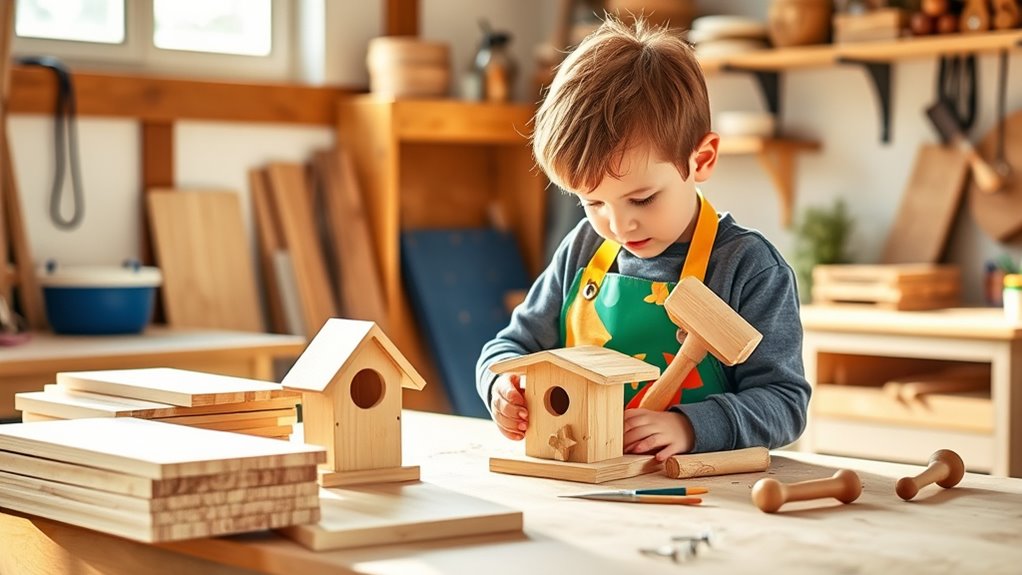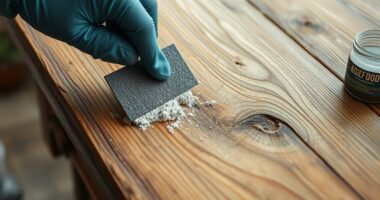Getting started with simple woodworking projects for kids is a great way to build their skills and confidence. Focus on easy, fun items like wooden blocks, picture frames, or storage boxes that use basic tools such as hammers, screwdrivers, and measuring tapes. Keep safety a priority with supervision and protective gear. If you keep exploring, you’ll find plenty of practical, creative projects to help your child learn and enjoy woodworking at home.
Key Takeaways
- Choose easy projects like wooden blocks, birdhouses, or storage boxes using safe, pre-cut materials and simple tools.
- Use age-appropriate tools such as small hammers, hand saws, and screwdrivers with proper safety gear.
- Follow clear, step-by-step instructions and downloadable plans to build confidence and ensure successful completion.
- Incorporate fun themes like animals or personalized designs to boost creativity and pride in craftsmanship.
- Supervise closely and maintain a safe workspace to promote safe, enjoyable woodworking experiences for kids.
Engaging Beginner Projects for Young Makers
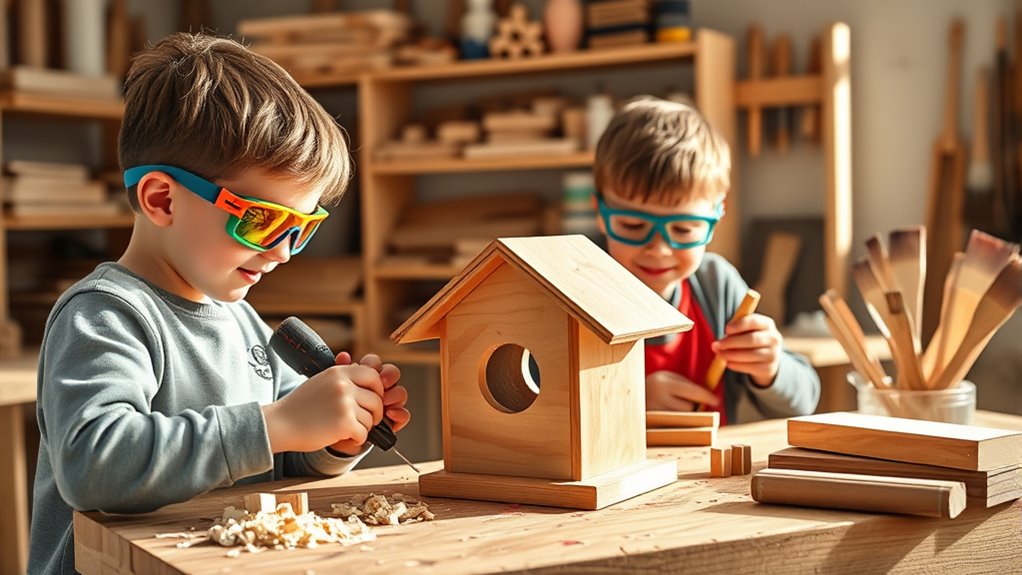
If you’re introducing kids to woodworking, starting with simple, engaging projects is key. Kids love woodworking projects for kids that are quick and fun, like making wooden blocks, birdhouses, or bookends. Use hand tools such as hammers, glue, and small saws to keep projects safe and manageable. Keep materials pre-cut or easy to measure so kids can focus on the craft without frustration. Incorporate themes like animals or personalized designs to boost creativity and make the process more exciting. Step-by-step instructions and downloadable plans are helpful, guiding kids through each project with confidence. These beginner projects not only develop basic skills but also foster a love for woodworking, setting a solid foundation for future craftsmanship.
Essential Tools and Materials for Kids’ Woodworking
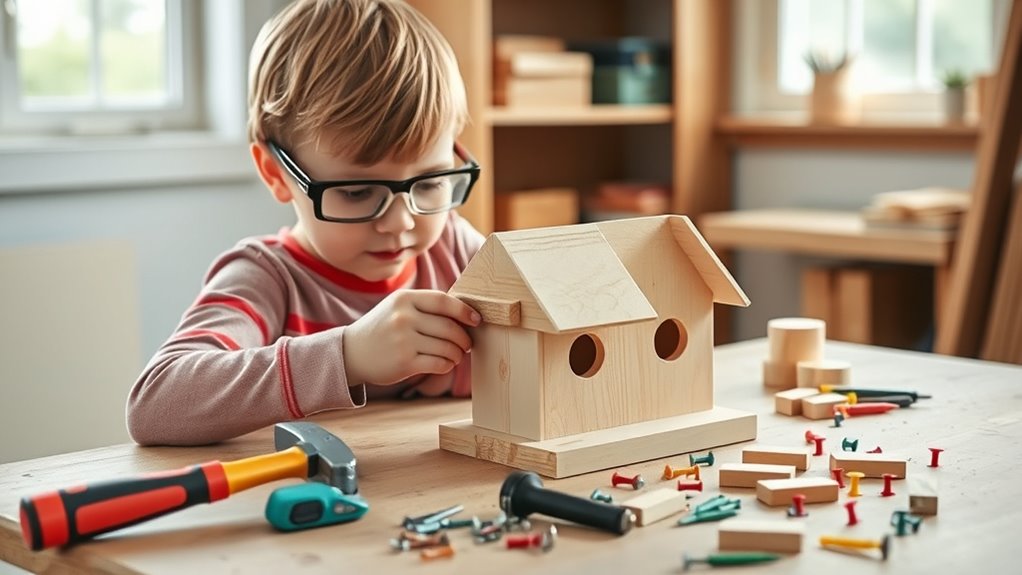
To guarantee safe and successful woodworking projects for kids, selecting the right tools and materials is essential. Kids woodworking tools like a small hammer, hand saw, screwdrivers, and measuring tape are designed for safe handling and ease of use. For beginner woodworking projects, safe woodworking materials such as softwoods (pine or cedar), plywood, and pre-cut shapes simplify assembly and reduce frustration. Using proper safety gear like goggles and dust masks protects young crafters during projects. Organizing tools and materials with labeled containers or tool chests keeps the workspace safe and tidy. Additionally, implementing best practices in safety and quality assurance can further ensure a positive woodworking experience for kids. Incorporating color accuracy considerations into project design can also help kids better understand visual effects and improve their craftsmanship skills. Paying attention to auditory processing needs can help create a more inclusive environment for children with sensory sensitivities. Utilizing appropriate safety equipment is vital to prevent accidents and ensure a secure working environment. Furthermore, selecting Glycolic Acid products suitable for young skin can help maintain skin health during outdoor activities.
Step-by-Step Guide to Building a Pencil Caddy

Building a pencil caddy is a fun and practical project that helps kids develop basic woodworking skills. This step-by-step guide uses ply templates to make measuring and cutting easier, perfect for wood projects for kids. You’ll start by gathering simple tools like a hammer and saw, encouraging hands-on learning and motor skills. The downloadable plans provide clear instructions, so you can follow each step confidently. As you progress, you’ll learn to measure accurately, cut precisely, and assemble parts neatly. This project also sparks creativity through design options, making it both educational and enjoyable. With patience and focus, you’ll create a functional storage solution for pencils and stationery, giving kids a sense of achievement and the confidence to try more woodworking adventures. Additionally, introducing kids to safe tool use ensures a positive and secure experience throughout the project. Incorporating safety precautions can further help prevent accidents and ensure a smooth building process. Engaging children in educational activities like woodworking can enhance their problem-solving skills and foster a lifelong interest in hands-on learning. Moreover, exploring innovative materials can inspire young makers to think creatively about sustainable options in their projects. Using eco-friendly and recycled materials not only benefits the environment but also encourages resourcefulness in young crafters.
Creative Outdoor Storage Solutions
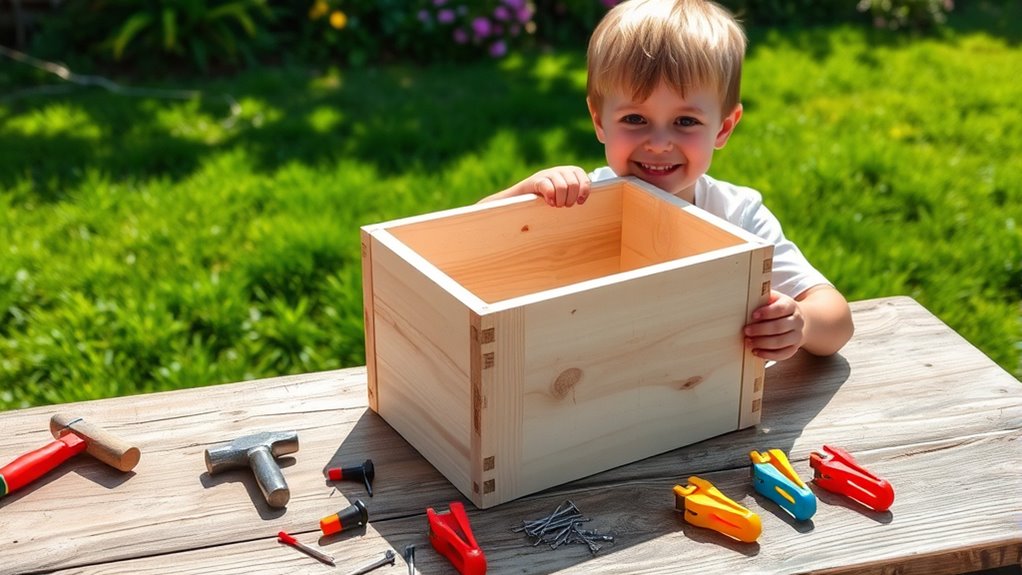
Looking for simple ways to keep your backyard organized? Creating outdoor storage solutions like crates and boxes is a great way to tidy up and teach kids woodworking skills. Building a customizable outdoor storage crate allows children to learn basic carpentry while making a practical addition to your yard. These projects promote making weather-resistant furniture that can withstand outdoor elements, ensuring durability and longevity. Online plans are often adjustable, encouraging creativity and problem-solving. By constructing outdoor storage, kids grasp the importance of organization and gain hands-on experience with outdoor woodworking techniques. Self watering plant pots are another project that can teach kids about plant care and sustainability. These projects make yard cleanup fun and functional, turning clutter into a manageable and engaging activity for the whole family. Incorporating weather-resistant materials into your projects can further enhance their durability against the elements. Additionally, understanding website performance metrics can help you optimize your project sharing sites to reach more DIY enthusiasts. Being aware of local store hours can also help plan shopping trips for supplies efficiently, ensuring you have everything needed for your woodworking projects.
Crafting Practical Items Like a Wooden Spoon or Cutting Board
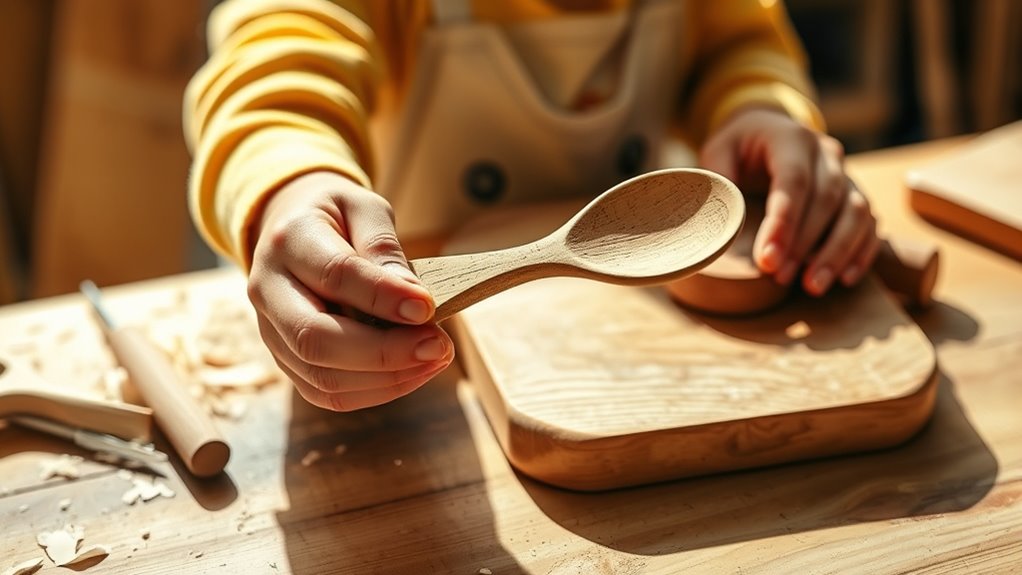
Choosing the right wood is key for making safe, durable spoons and cutting boards, so consider options like maple or beech. Use safe, sharp tools for cutting and shaping, and always sand smoothly to prevent splinters. Finishing with natural oils not only protects the wood but also creates a food-safe, polished surface kids can be proud of. Additionally, applying a protective finish helps extend the lifespan of the items and ensures safety during use. Incorporating child-friendly materials can also promote a calming environment during woodworking activities, especially for children with special needs. Being aware of proper maintenance and cleaning techniques ensures that the DIY items remain safe and in good condition over time.
Selecting Suitable Wood Types
When selecting wood for practical items like a wooden spoon or cutting board, it’s important to choose the right type to guarantee durability and safety. Hardwoods such as maple, cherry, and walnut are ideal because they’re dense and resistant to moisture, making them perfect for kitchen tools. Softwoods like pine and cedar can work for spatulas but need proper sealing with food-safe finishes like mineral oil or beeswax to prevent splintering and absorption of food juices. Always pick pieces of wood free of knots, cracks, or defects that could weaken the structure or cause safety issues. Additionally, choosing vetted wood sources ensures the material is free from harmful chemicals and safe for food contact. For kitchen tools, selecting moisture-resistant wood can help extend their lifespan and maintain safety during use. Ensuring the wood has a smooth surface also minimizes the risk of splinters and enhances comfort during use. Incorporating proper sealing techniques helps protect the wood from moisture and prolongs its usability.
Safe Cutting and Finishing
To guarantee safety and quality when crafting practical wooden items like spoons or cutting boards, it’s essential to use proper cutting and finishing techniques. Always supervise children, especially when handling safe tools like small hand saws or plastic safety saws. Carefully sand edges and surfaces with fine-grit sandpaper to prevent splinters and ensure smoothness. After shaping, apply non-toxic finishes such as flaxseed oil or beeswax to protect the wood and make it food-safe. Teaching proper techniques, like cutting along straight lines and finishing gently, helps kids achieve precise, safe results. Here’s a quick guide:
| Step | Tool/Supply | Purpose |
|---|---|---|
| Cutting | Safe saws | Shape the wood safely |
| Sanding | Fine-grit sandpaper | Smooth edges and surfaces |
| Finishing | Non-toxic finishes | Protect and make safe for use |
Additionally, choosing the right woodworking tools can make the project safer and more manageable for children.
Fun and Functional Projects for Home and Play
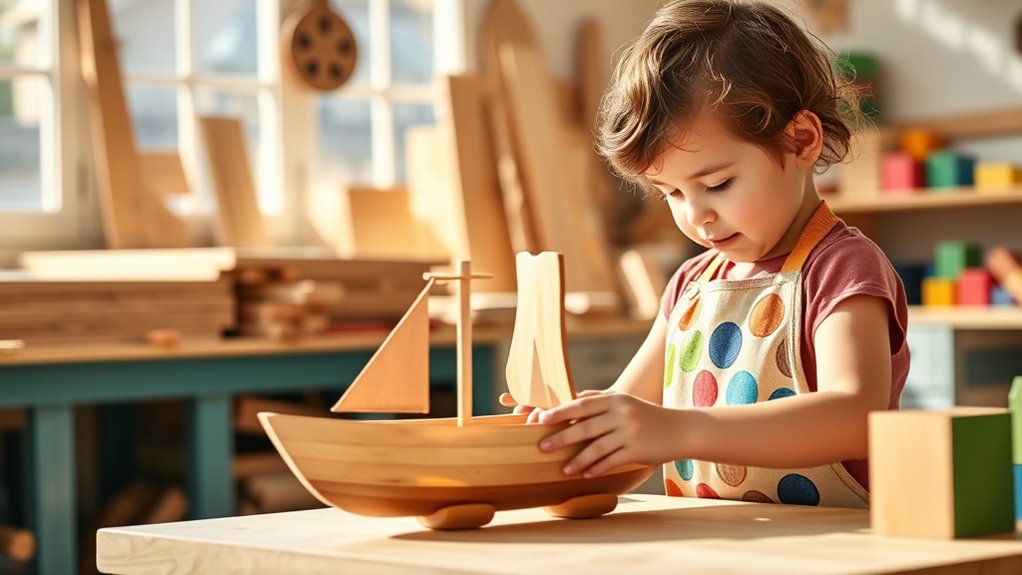
Creating fun and functional projects for home and play helps kids learn useful skills while expressing their creativity. With simple tools and clear plans, they can build items like birdhouses or bookends that brighten up your space. These projects make woodworking enjoyable and give children a sense of pride in their practical, playful creations.
Creative Craft Ideas
Looking for fun ways to introduce kids to woodworking? Creative craft ideas are perfect for blending artistry with basic skills. Kids can use simple materials like sticks, nails, and scrap wood to create unique projects that boost their imagination and fine motor skills. These easy woodworking crafts include making textured stamps, decorative sculptures, and personalized art pieces, encouraging artistic exploration. Projects like gnome catapults or textured stamps promote hands-on learning and fundamental techniques. Crafting with wood helps children understand design principles while making functional items for home or play. These projects are engaging, accessible, and foster creativity, making woodworking enjoyable and educational for young makers.
- Develops fine motor skills and hand-eye coordination
- Sparks imagination through personalized design
- Teaches basic woodworking techniques simply
- Combines art and function effortlessly
- Encourages independent, creative expression
Practical Home Projects
Building on kids’ enjoyment of artistic projects, practical home items offer a rewarding way to combine fun with function. Through woodworking and DIY projects, kids can create useful items like birdhouses, bookends, and storage boxes that teach basic skills. These projects typically use simple tools such as hammers, saws, and sanders, making them perfect for beginners. Designing functional pieces like door stops or caddies helps children grasp measurements, planning, and spatial awareness. Plus, they can personalize their projects with paint, decorations, or patterns, adding a creative touch. Not only do these practical projects foster a sense of accomplishment, but they also produce household items that can be enjoyed daily. Engaging in woodworking this way builds confidence and practical skills in kids while giving your home charming, handmade touches.
Tips for Ensuring Safety and Success in Kids’ Woodworking
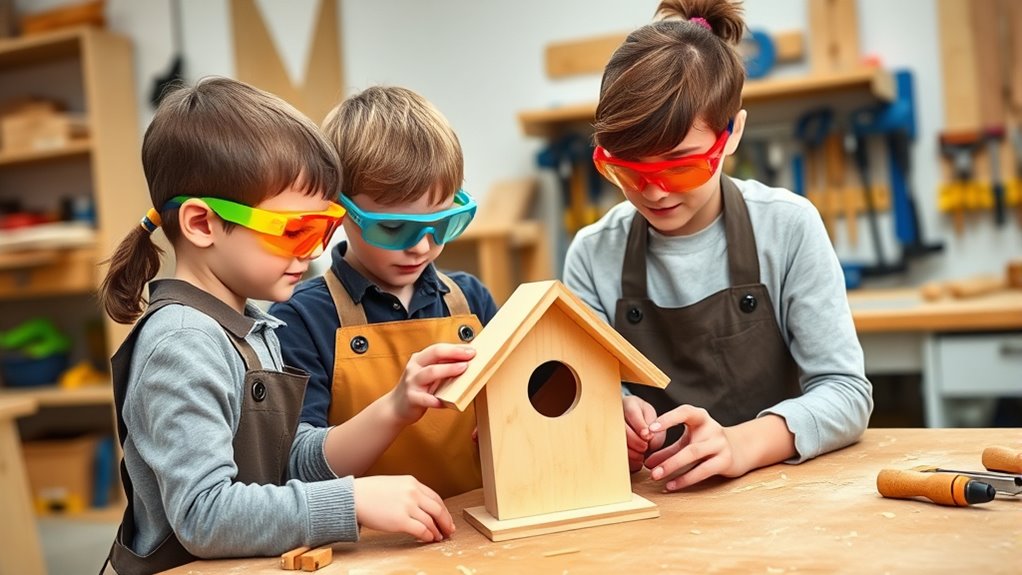
To guarantee kids have a safe and successful woodworking experience, close supervision is essential at all times. Ensure they wear safety gear like goggles and gloves to protect against injuries. Use age-appropriate tools such as kid-sized hammers, screwdrivers, and saws designed for safe handling. Teach children proper safe work habits, like keeping fingers away from blades and handling tools carefully. Start with simple projects that involve minimal cutting and assembly to build confidence and reduce risks. Regularly inspect tools and the workspace for hazards to prevent accidents. Establish clear safety rules before starting and reinforce them throughout the project.
Supervise children closely, use safety gear and age-appropriate tools, and start with simple projects to ensure safe woodworking experiences.
- Emphasize the importance of protective gear
- Choose tools suitable for their age
- Teach proper handling techniques
- Keep the workspace hazard-free
- Start with simple, manageable projects
Inspiring Ideas to Spark Creativity and Confidence

Starting with simple woodworking projects can ignite your child’s creativity and boost their confidence. Kid-friendly projects like building bookends or birdhouses give kids a sense of achievement by creating functional items. These activities introduce basic tools such as hammers and saws, helping them develop craftsmanship skills and understand safety. When children complete small, achievable projects, they’re encouraged to problem-solve and plan their designs, fostering creativity and confidence. Step-by-step plans and templates make woodworking accessible, making success feel within reach. The table below highlights how these projects build a foundation for growth and enjoyment:
| Skill Development | Creative Expression |
|---|---|
| Craftsman skills | Unique project designs |
| Safety awareness | Personal touches |
| Problem-solving | Imagination in planning |
| Confidence building | Pride in finished work |
Frequently Asked Questions
What to Make With Kids With Wood?
When you ask what to make with kids using wood, you’re exploring fun, easy projects that teach basic skills. You can start with simple items like wooden blocks or picture frames, which help kids learn measurement and cutting. Fun ideas include birdhouses, bookends, or small storage boxes. These projects keep kids engaged, boost their confidence, and introduce them to woodworking in a safe, creative way.
What Is a Simple Wood Work Project?
Think of a simple woodwork project as a gentle breeze guiding you through a creative forest. It’s an easy adventure where you shape basic materials into functional or decorative items without getting lost in complexity. You’ll use simple tools, measure with a steady hand, and assemble with confidence. These projects are your stepping stones, turning raw wood into charming pieces while building foundational skills and sparking joy in your craft.
What’s the Easiest Thing to Make Out of Wood?
When you ask what’s easiest to make out of wood, you’re probably thinking of beginner-friendly projects. You can start with a wooden block or cube, which only needs cutting and sanding. Wooden coasters or trivets are simple, using thin slices. A wooden spoon or spatula is functional and straightforward, made from one piece. Small picture frames or birdhouses from pre-cut panels are also great beginner projects, requiring minimal tools and effort.
Conclusion
Now that you’ve explored these simple woodworking projects for kids, you’re equipped to turn little hands into mighty creators. With patience and safety, you could be shaping future artisans who might just build a world where nothing is impossible. Remember, every project you complete is a stepping stone to confidence and skill—like planting a seed that could grow into the most incredible craftsmanship you’ve ever seen. Keep inspiring and creating—your young maker’s journey has only just begun!
